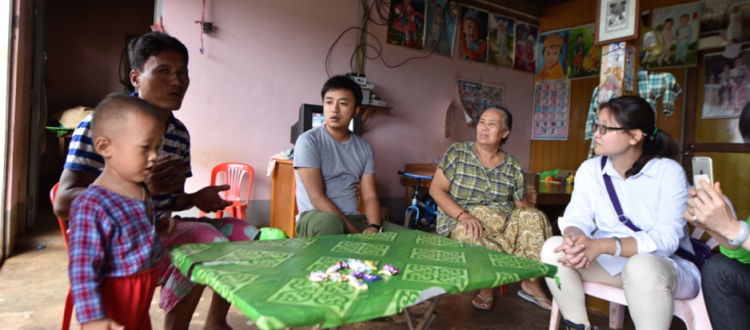Investigating the Impact of the Myitsone Dam on an Immigrant Village in Myanmar
MYANMAR (July 14-20, 2015) – GEI program offers spent nearly a week during July in the Aung Min Thar immigrant village near the Myitsone Dam in Myanmar conducting an in-depth investigation into the effects of the Myitsone Dam construction on the daily life of the local residents.
The investigation sought to provide a thorough understanding of the village life and consisted of three parts, a community discussion, household visits, and individual interviews. The findings of the investigation would lay the foundation to launch a program promoting local livelihood. The three GEI program officers involved were Ms Cao Sirui, Ms Li Ying, and Ms Kong Linghong.
Researching the Myistone Hydropower Project’s Impact on Communities

Obsolete Facilities at the Myistone Dam Site – GEI 2015
GEI has been involved in leading discussions about the impact of the dam on villager’s life since the dam’s controversial construction halt on Sept. 30, 2011. In fact, just months after the announcement, GEI held a closed-door meeting with relevant officials from the Chinese government and Myanmar government, academic representatives and members of NGOs for an open and thorough discussion on the Myitsone hydropower project.
Since 2012, GEI has remained dedicated to monitoring the impact of the Myitsone Dam and hence, was a very suitable leader into the three-part villager-oriented investigation.
The investigation, led by Ms Cao, Ms Li and Ms Kong successfully brought to light the reality of the village life and the impacts of the dam, as follows:
Part 1: Community Discussion

Holding an open discussion with villagers – GEI 2015
The community discussion part of the investigation occurred at a newly-built village church and welcomed 24 villagers to participate. The GEI program officers, working with a local organization, led the discussion and covered three primary points: the villager’s perspective on the Myitsone dam, the impact of 2011 halt to the dam construction and the potential impacts of the dam on their way of life. The discussion proved extremely fruitful and lasted two hours. The participant demographic was split as nine female and 15 male, with an average age of 45 years old.

GEI Program Officers Li Ying (center), CAO Sirui (third from right) and KONG Linghong (second from right) and villagers – GEI 2015
Part 2: Home Visits

A women sewing in her traditionally rattan-constructed home- GEI 2015
Following the community discussion and despite heavy rain, the GEI officers traveled to villager’s homes to gain first-hand knowledge of the villager’s daily life. Specifically, the GEI officers visited masters of traditional weaving and a small-shop owner.

Speaking with the small-shop owner and his family – GEI 2015
Part 3: Individual Interviews
Finally, so to better understand the agricultural production of the village and Myitkyina as a whole, the GEI officers held an individual interview with the director of the Agriculture Bureau of Myitkyina.

Conducting the interview with the Agriculture Bureau – GEI 2015
About the Myitsone Dam
On September 30, 2011, President Thein Sein declared that Myitsone dam project would be shelved in his term for reasons of natural scenery, replantation and crop protection and preservation of livelihood. The decision drew wide attention and debate as halt of the project not only brought substantial economic damage to China and Myanmar but it also had a large negative impact on local villagers of Aung Min Thar. The dam was originally invested in by State Power Investment Corporation, Ministry of Electric Power No.1, and Asia World Company.


Sites of Aung Min Thar Village – GEI 2015

